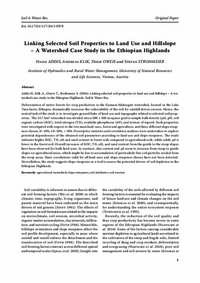Linking Selected Soil Properties to Land Use and Hillslope – A Watershed Case Study in the Ethiopian Highlands

Authors:
Deforestation of native forests for crop production in the Gumara-Maksegnit watershed, located in the Lake
Tana basin, Ethiopia, dramatically increases the vulnerability of the soil for rainfall driven erosion. Hence, the
central task of the study is to investigate general links of land-use and topography related to selected soil prop-
erties. The 53.7 km2 watershed was divided into a 500 × 500 m square grid to sample bulk density (ρd), pH, soil
organic carbon (SOC), total nitrogen (TN), available phosphorus (AP), and texture of topsoil. Such properties
were investigated with respect to the two main land-uses, forest and agriculture, and three different slope steep-
ness classes, 0–10%, 10–30%, > 30%. Descriptive statistics and correlation analyses were undertaken to explore
potential dependencies of the obtained soil parameters according to land-use and slope steepness. The study
indicates higher SOC, TN, silt and sand content in forest soils compared to agricultural soils, while solely ρd is
lower in the forest soil. Overall increases of SOC, TN, silt, and sand content from the gentle to the steep slopes
have been observed for both land-uses. In contrast, clay content and ρd seem to increase from steep to gentle
slopes on agricultural areas, which might be due to accumulation of particularly fine soil particles eroded from
the steep areas. Basic correlations valid for all land-uses and slope steepness classes have not been detected.
Nevertheless, the study suggests slope steepness as a tool to assess the potential drivers of soil depletion in the
Ethiopian Highlands.
